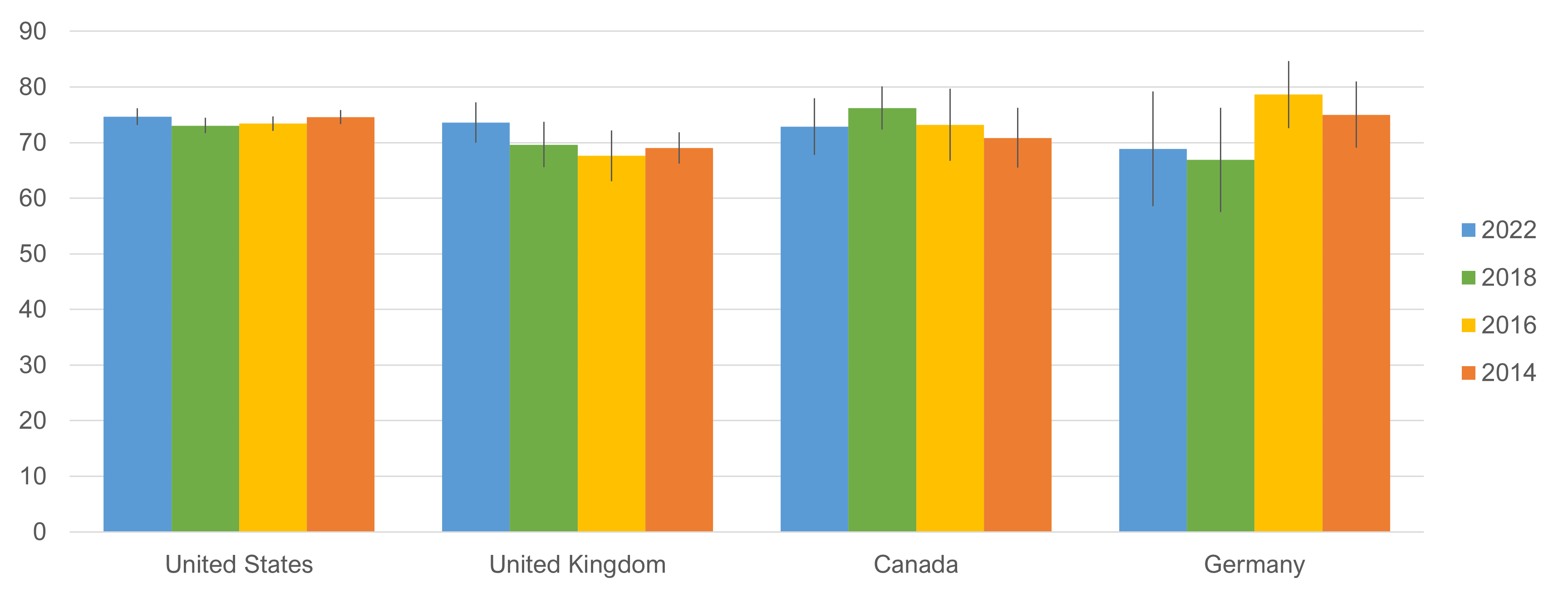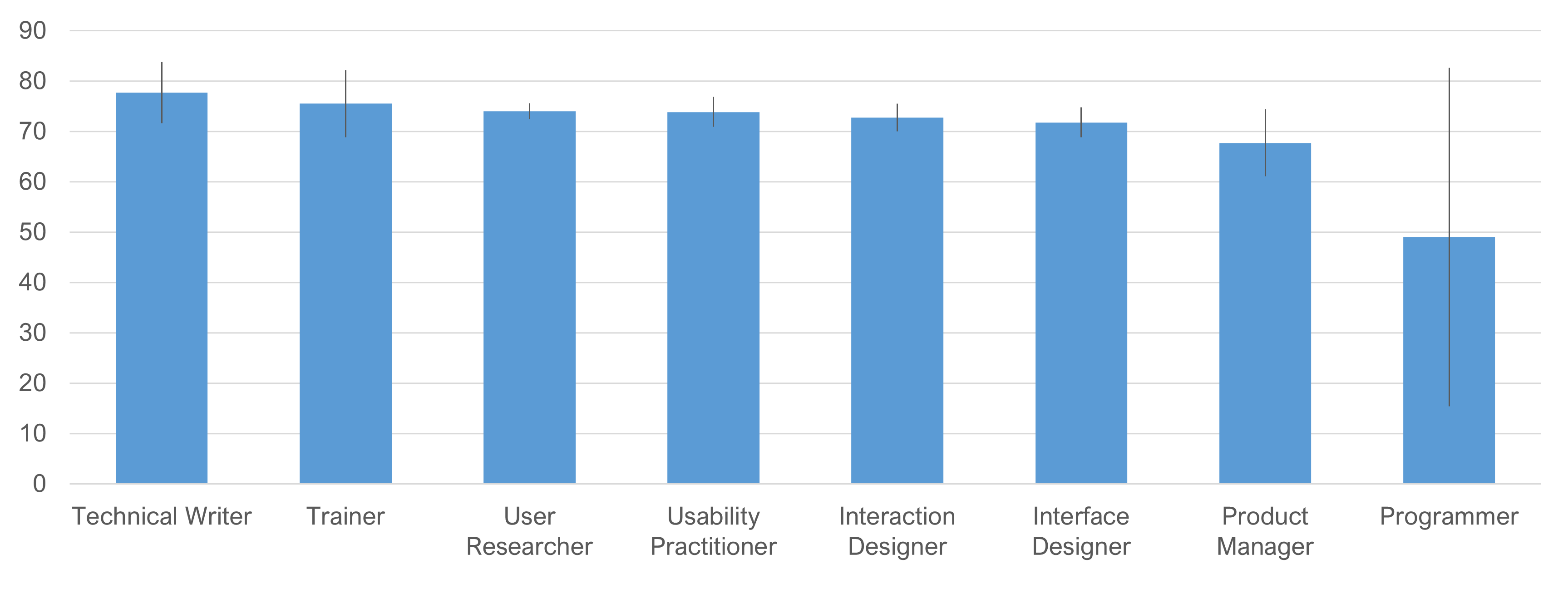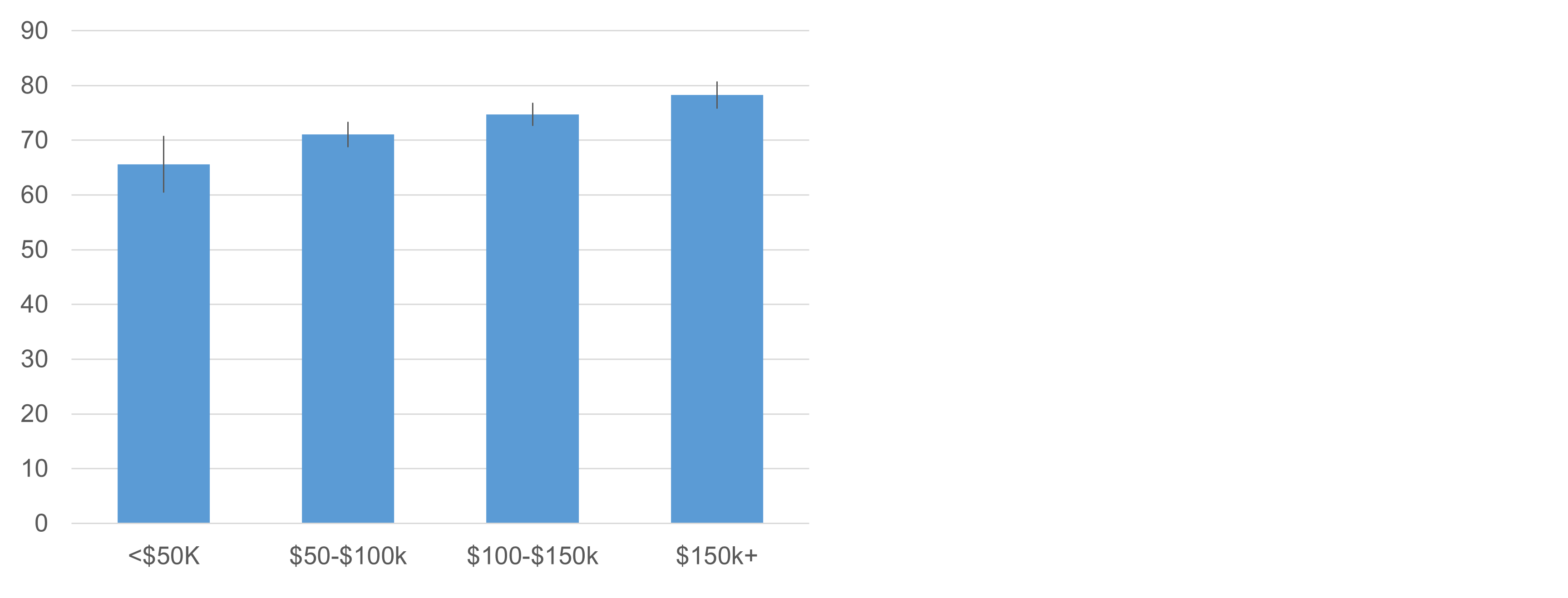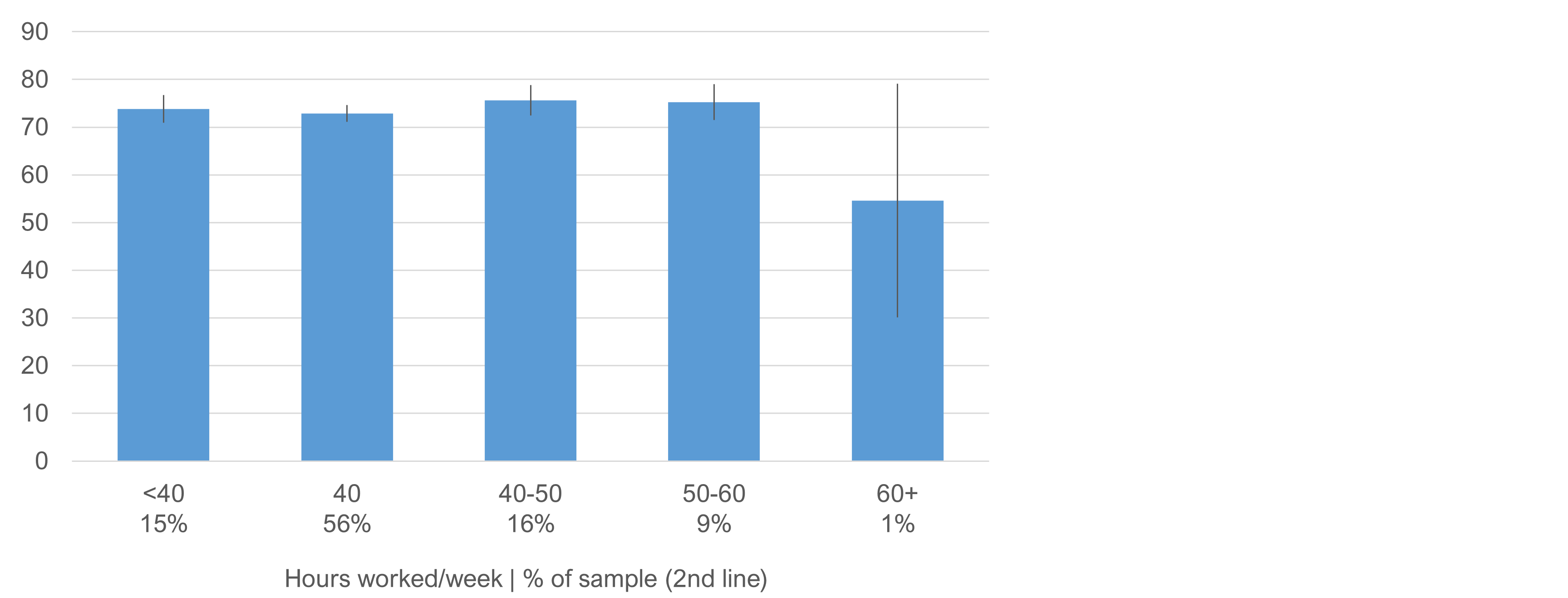 We’ve all got bills to pay. But there is more to a job than just the pay.
We’ve all got bills to pay. But there is more to a job than just the pay.
The type of work you do and the people you work with have a lot to do with a sense of satisfaction. Consequently, job satisfaction has been measured extensively for decades in many industries.
To gauge how satisfied UX practitioners are with their jobs, the UXPA has been asking respondents a job satisfaction question since 2014. Participants are asked on a scale of 0 to 100, with 0 being not satisfied at all and 100 being completely satisfied, where they rate their overall job satisfaction with their current position.
With the 2022 UXPA survey results in we have a new data point. As shown in Figure 1, the mean satisfaction score from 625 respondents in 2022 is 74; that hasn’t changed much since 2014.

Comparing UX Satisfaction to Other Industries
For any measure to be meaningful, we must compare it to something. While there isn’t a database available to compare UX satisfaction scores, other 100-point scales can be used to assess job satisfaction. There is also research that shows that single-item measures of job satisfaction highly correlate with multi-item measures. We, therefore, looked for other single-item measures of job satisfaction across industries.
From what we could find, Glassdoor has the most up-to-date job satisfaction scores across enough comparable jobs to provide context to the UXPA satisfaction scores. Glassdoor uses a “Job Score” based on a five-point scale (5.0 = best job, 1.0 = bad job). As far as we know, Glassdoor has not published any psychometric validation of its job scores or sampling methodology (keep that in mind while reading), but a paper published in 2019 found a correlation between Glassdoor satisfaction ratings and ratings from results of the 2017 Federal Employee Viewpoint Survey significantly correlated (r = .516). Glassdoor publishes a list of its top jobs with satisfaction scores for comparison. To even make this list, a job has to be relatively high in satisfaction.
To compare the UXPA satisfaction data to the Glassdoor data, we converted the Glassdoor data to a percentage using linear interpolation. For a five-point scale, this is (x−1)/4, expressed as a percentage, where x is the average on the five-point scale. So, 4 on a five-point scale becomes 75%, which corresponds to 75% on the UXPA satisfaction scale (75 out of 100 becomes 75%). Table 1 shows these percentages for a selection of jobs pulled from Glassdoor’s top jobs.
| Job | Satisfaction Score % |
|---|---|
| Reliability Engineer | 83% |
| Creative Manager | 83% |
| Data Scientist | 80% |
| Mobile Developer | 78% |
| UXPA Average | 74% |
| Data Analyst | 73% |
| UI Developer | 70% |
| UX Designer | 70% |
| Business Analyst | 65% |
| Solutions Architect | 65% |
| Project Manager | 63% |
| Nurse Practitioner | 63% |
Table 1: Job satisfaction scores from Glassdoor (converted to % scale) and compared to the UXPA average score.
The average UXPA satisfaction scores place well within Glassdoor’s top jobs list (e.g., UX Designer is #24 in their 2022 list of top 50 jobs). In fact, the highest satisfaction scores reported for Glassdoor’s top jobs cap out at satisfaction scores of 4.3 (or a corresponding score of 83% on the 0–100-point scale). This suggests the jobs within the UX profession (as measured by the UXPA survey) are not too far from the top.
Explaining Satisfaction
When we sought to understand the key drivers of salary from the 2022 UXPA Salary Survey, we were able to explain a substantial 68% of the variance (similar to years past). When applying the same multivariate regression technique to satisfaction, we could explain only a much lower 3% of the variance. (This isn’t surprising, because the correlation between salary and satisfaction was a small but statistically significant .177, p < .0001.)
Part of the reason could be the restriction of range (75% of respondents rated their job satisfaction as 65 or greater).
Almost all of the sample is salaried, working full time, and not performing manual/physical labor. These job characteristics, according to research from PEW, are important drivers of job satisfaction in the U.S.
Historically, we find that the variables that have had a statistically significant impact on satisfaction include country, job, salary, and the number of hours worked per week. To find these relationships, we sometimes have to look at the extremes in some variables and not the full range, suggesting some nonlinear relationships between satisfaction and job characteristics.
Job Satisfaction by Country
In the analysis of salaries, the biggest predictor of salary was where you live, both the country and, within the U.S., the region. The highest salaries are in places where it’s very expensive to live (e.g., Northern California). To see how satisfaction differs by geography, we compared satisfaction scores by the countries with the most respondents for the last four salary surveys.
Figure 2 shows that respondents from the U.S., U.K., and Canada reported nominally (but not statistically) higher satisfaction scores in 2022 than those in Germany. The lower scores from the 15 German respondents could be from genuinely lower job satisfaction, normal small-sample variation, or different regional/cultural interpretations and usage of rating scales. For example, we’ve seen instances in the literature and our own research where respondents in Japan generally respond lower than respondents in western countries to the same stimuli and rating scale.

Job Satisfaction by Job Title
Respondents in the UXPA salary survey were asked “Which describes your current position? (Select all that apply).” We found the most notable differences in job satisfaction came from respondents who selected “Technical Writer” (selected by 12) or “Programmer” (selected by 5). Figure 3 shows the mean satisfaction scores. A more substantial number of respondents selected User Researcher (382), Usability Practitioner (125), Interaction Designer (131), and Interface Designer (116).

Income and Satisfaction
Money might not buy happiness, but higher incomes are associated with higher job satisfaction. As shown in Figure 4, respondents who reported salaries above $150K (122 respondents) reported statistically higher average satisfaction scores than those with salaries of 100K or less (248 respondents). In one of their studies, Glassdoor also found higher pay was associated with higher satisfaction.

To control for possible country effects, we examined differences within the U.S. only. We found similar results, albeit to a lesser degree. For U.S. respondents, those making above $150K (119 respondents) reported 7% higher satisfaction scores than those making between $50–100K (108 respondents—a statistically significant difference). Only seven respondents reported a salary of less than 50K in the U.S.; that, coupled with high variation, contributed to the absence of statistically significant differences between other salary groups.
Working More Pays More … but Too Much May Lead to Less Satisfaction
Respondents also reported how many hours they worked per week (Figure 5). A little more than half (56%) reported working exactly 40 hours per week, and the bulk of respondents (72%) reported working exactly 40 or between 40 and 50 hours per week.
Interestingly, the average satisfaction rating for those who reported working 40–50 or 50–60 hours a week was nominally (though not statistically) higher than those who reported working exactly 40 hours per week or less than 40 hours.
However, things changed for those who exceeded 60 hours. The five respondents (about 1% of the sample) who reported working more than 60 hours have an average satisfaction that is 34% lower than those working fewer hours. This difference is not statistically significant because the sample size for 60+ hours was very small, and there was a lot of variability in satisfaction ratings among those five respondents (25, 30, 65, 70, 83).

Additional Variables that Didn’t Predict Satisfaction
We examined several other variables based on the research in the job satisfaction literature. Although some cases had some small differences, they don’t add to the predictive ability of satisfaction (meaning other variables already accounted for what they’re adding). These variables are gender, job level, company size, experience, age, U.S. region, and supervising direct reports. A few notes on some of these:
- Job level had no significant effect on satisfaction (p = .20). Those with entry-level and mid-level nonsupervisory jobs have similar satisfaction scores (71). The mean satisfaction rating for senior-level supervisory jobs was 77.
- Company size also doesn’t matter much (p = .93). While the 86 respondents at smaller companies (1–100 employees) reported the highest satisfaction level (75), it wasn’t statistically different from larger companies (~73–74).
- The oldest respondents (56+) reported 8% higher satisfaction scores than the youngest respondents (18–25), but it wasn’t statistically different (p = .11).
- Those with the most experience (21+ years) tended to be nominally (6%) more satisfied than those with the least experience (0–2 years), but the difference was not statistically significant (p = .26). This is the opposite of what was reported by Glassdoor in 2015.
Summary
Most in the UX profession report high job satisfaction, and that hasn’t changed much since 2014. The average satisfaction in the profession is near the top of other high-satisfaction jobs. Using multiple regression analysis with variables that account for 68% of salary variation, we predict only 3% of the variation in job satisfaction (low but highly statistically significant, p < .0001). The low explanatory power may be due to range restriction (most people are satisfied) and nonlinear relationships. In the 2022 UXPA survey, out of multiple analyses of job satisfaction, the only statistically significant driver was job salary (Figure 4).


